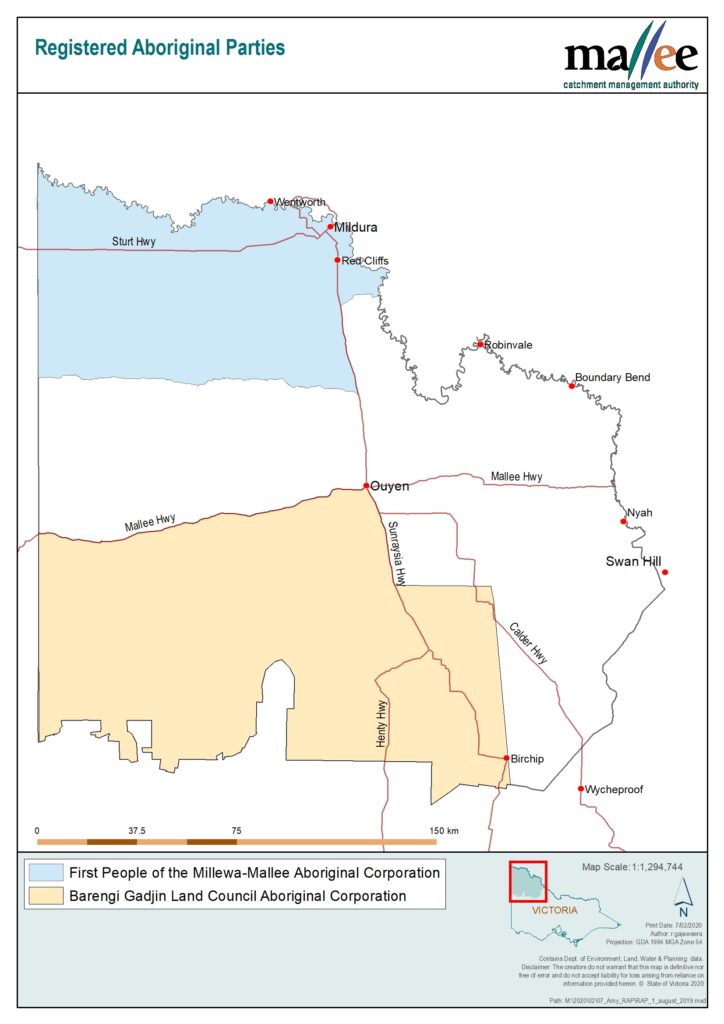For many thousands of years, the Country was managed and cared for by local First Peoples. As custodians of the oldest living culture in the world, Traditional Owners have always understood the responsibility that comes with looking after and speaking for the Country of their ancestors and future generations.
In Victoria, there are three different processes for groups to become formally recognised as Traditional Owners of Country: as a Registered Aboriginal Party (RAP) under the Aboriginal Heritage Act 2006; through Native Title Determination under the Native Title Act 1993; and by Recognition and Settlement Agreement under the Traditional Owner Settlement Act 2010.
Registered Aboriginal Parties are the appointed statutory authority under the Aboriginal Heritage Act 2006 and are recognised as the primary guardians, keepers and knowledge holders of Aboriginal Cultural Heritage for their region.
There are currently two RAPs who represent the interests of Traditional Owners in their respective Country areas across the Mallee: Barengi Gadjin Land Council Aboriginal Corporation (BGLC) and First People of the Millewa Mallee Aboriginal Corporation (FPMMAC). the interests of Traditional Owners in their respective Country areas across the Mallee: Barengi Gadjin Land Council Aboriginal Corporation (BGLC) and First People of the Millewa Mallee Aboriginal Corporation (FPMMAC).

Figure 2 | Registered Aboriginal Party Areas in the Mallee
Barengi Gadjin Land Council (BGLC)
BGLC is the trustee for the Native Title rights and interest of the Wotjobaluk, Jaadwa, Jadawadjali, Wergai and Japagulk peoples, collectively known as the Wotjobaluk Nations; as recognised in a 2005 Native Title Consent Determination.
BGLC was appointed RAP status in 2007, with their area of responsibility encompassing much of the southern Mallee (Figure 2), including Wyperfeld National Park, and the Big Desert State Forest/Wilderness Area. It also extends into the Wimmera, North Central and Glenelg Hopkins regions.
The Wimmera Co-operative Management Agreement between the State and BGLC provides for the Wotjobaluk Peoples to participate in the management of certain parks and reserves within the determination area established under an Indigenous Land Use Agreement (ILUA). The Wotjobaluk Peoples also assert interests in land outside the ILUA boundary.
The Victorian Government and BGLC are currently negotiating a Recognition and Settlement Agreement and associated Traditional Owner Land Management Agreement. This will enable the Wotjobaluk Peoples and the State of Victoria to jointly manage agreed national parks, conservation reserves and other Crown land when they are transferred to BGLC as Aboriginal Title.
The BGLC Country Plan: Growing What is Good Country Plan — Voices of the Wotjobaluk Nations (2017), highlights connections to Country, identifies impacts of colonisation, and outlines goals, priorities and actions to progress their vision of: “Wotjobaluk Nations working together as custodians of Culture, Country, Heritage, Lore and Language; sharing our values and representing the rights and interests of our People”.
The overarching goals of the Country Plan include: strong and healthy Culture; healthy Country; an engaged and connected community; recognition and respect; economic sustainability; healthy Peoples; and a strong voice.
First People of the Millewa-Mallee Aboriginal Corporation (FPMMAC)
The FPMMAC RAP area encompasses a large portion of the northern Mallee (Figure 2), including the Murray River floodplain and its associated waterways; and parts of Murray-Sunset National Park.
FPMMAC was registered in 2015 and appointed RAP status in 2018. They are currently seeking to negotiate a Recognition and Settlement Agreement and Native Title determination over land that includes and extends their current RAP area.
FPMMAC has been formed by Latji Latji and Ngintait Traditional Owners. They are in the process of developing a Country and Water Plan, with their interim Country-Culture-People Action Plan (2020) identifying the following objectives: “Our Action Plan and strategic Country and Water Plan seek to repair the natural environment and our people’s place in the environment:
- We will do this by rejuvenating the land, floodplains and river system, while rejuvenating our culture and people.
- We will do this with and by our people, in conjunction with the broader community and governments.
- We are implementing our Indigenous cultural model of self-determination, on Country with Culture for People”.
There are also several groups in the Mallee with strong connections to Country that do not currently have formal recognition. This includes Gilbie Aboriginal Corporation and Murray Valley Aboriginal Corporation, Latji Latji Mumthelang, Nyeri Nyeri, Tati Tati, Wadi Wadi, Weki Weki, Wemba Wamba and Werigia Traditional Owners. These groups play an important and active role in the planning for, and delivery of, programs seeking to protect culture and cultural values on Country.


